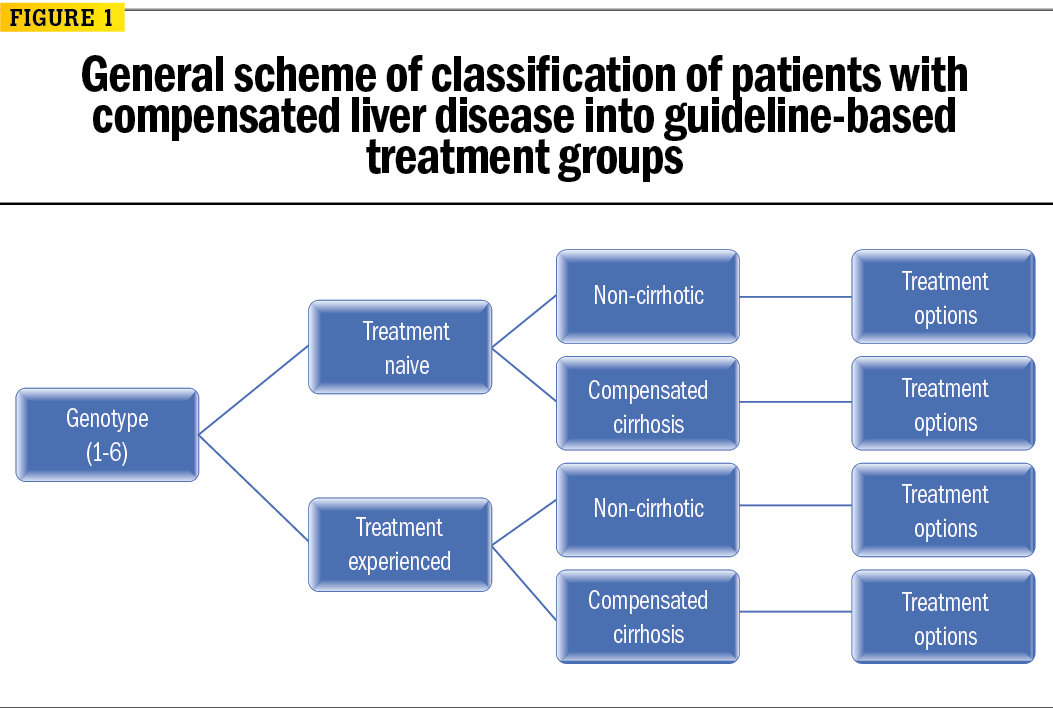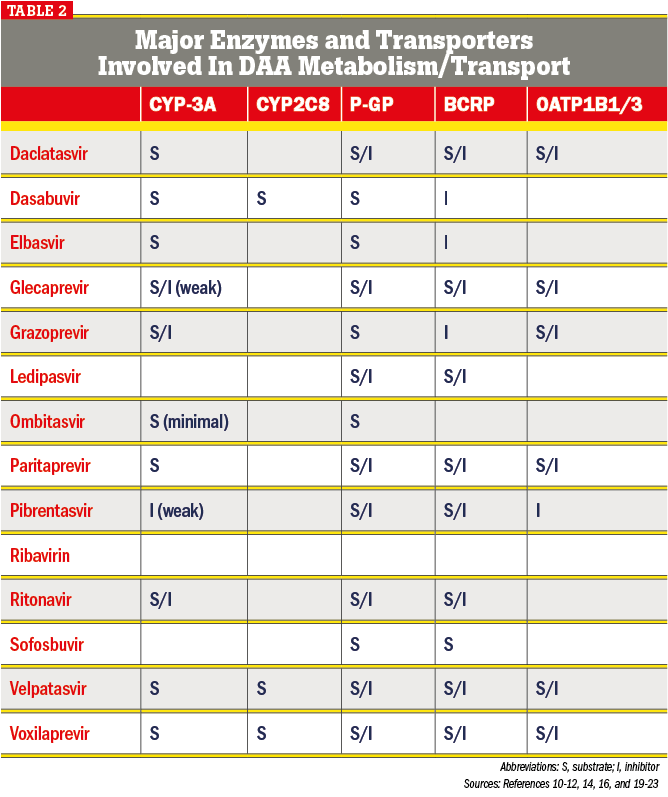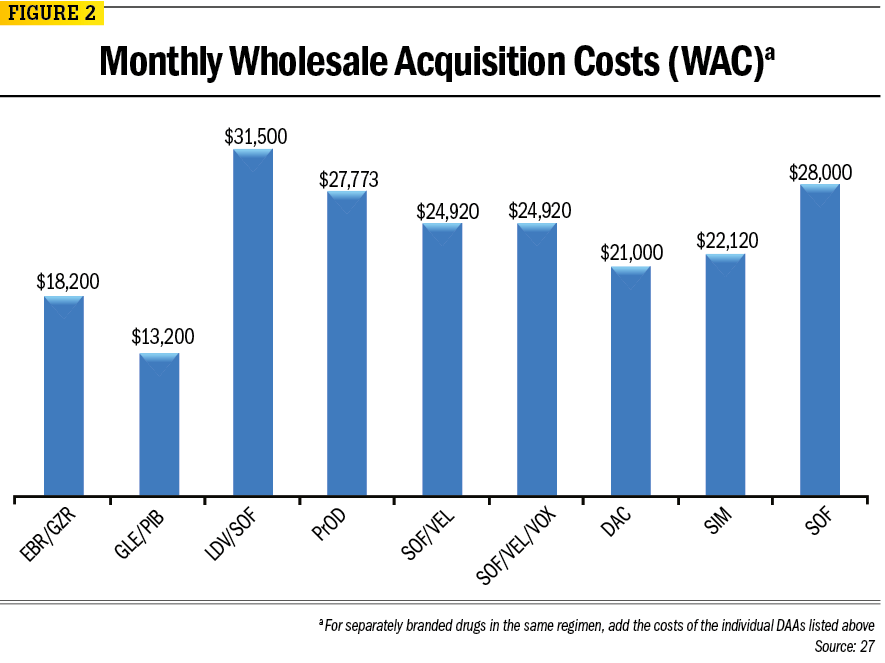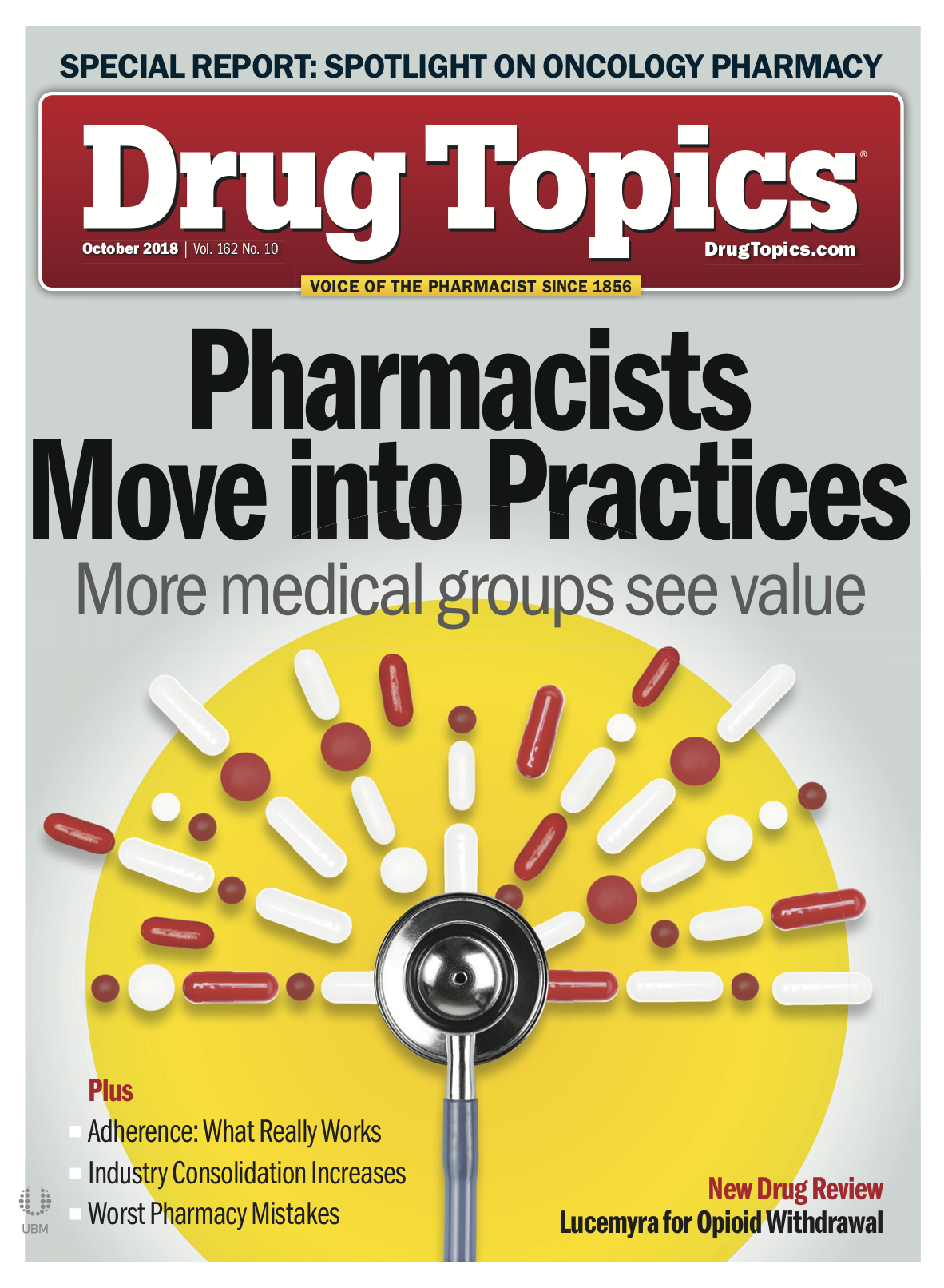Advances in Hepatitis C Treatment
This peer-reviewed article will show you what you need to know about the latest breakthroughs and treatment options.

Fig. 1, Click to expand

Hepatitis C is caused by the hepatitis C virus (HCV). HCV causes an acute infection which may lead to chronic infection in an estimated 55% to 85% of patients.1 Chronic infection is defined as at least 6 months of detectable viral HCV RNA in the blood.2 There are no commercially available vaccines for HCV, but there are many highly successful curative treatment options.
Chronic HCV infection carries many life-threatening sequelae including both end-stage liver disease (ESLD) and hepatocellular carcinoma (HCC).2 An estimated 185 million worldwide have chronic HCV, with 3.5 million cases in the United States.3 More than half of those infected are unaware of their infection.4,5
HCV is blood-borne, with the leading route of transmission for acute infection being intravenous drug use (IDU). Other potential risk factors include mother-to-child transmission, intranasal drug use, and long-term hemodialysis.4
There are currently seven identified genotypes of HCV that are further subdivided into 67 subtypes.6 Genotypes 1, 2, and 3 are most common in the United States, accounting for 75.8%, 12.0%, and 10.4% of cases, respectively.6 The American Association for the Study of Liver Diseases and Infectious Diseases Society of America (AASLD-IDSA) released HCV treatment guidelines that are organized by genotype.4 Guideline-directed therapy for HCV involves several levels of subgrouping to further optimize the probability of treatment success. Figure 1 illustrates this classification process. Recommendations for patients outside the groups listed (e.g., patients with decompensated cirrhosis) are made in the following sections.
The goal of treatment is to reduce all-cause mortality and liver-related morbidity, including ESLD and HCC. Successful treatment involves curing the infection. Clinically, this is done by achieving a sustained virologic response (SVR12), defined as an undetectable HCV RNA count (viral load) at least 12 weeks after completion of therapy.4
Treatment is accomplished with the use of combinations of direct-acting antivirals (DAAs) for 8, 12, or 24 weeks. DAAs target one of three key proteins of the HCV viral replication cycle: NS3/4A protease enzyme, NS5A replication complex, or NS5B polymerase enzyme. Inhibition of NS5A or NS5B prevents RNA replication, while NS3/4A inhibition alters protein modification.6 Current guideline-recommended regimens are designed to inhibit at least two of these proteins. Generally speaking, the cure rate for all DAA regimens is above 90% for any given regimen and population, and, in most cases is above 95%.7
DAA treatment regimens in the current guidelines include: glecaprevir/pibrentasvir (GLE/PIB, Mavyret), elbasvir/grazoprevir (EBR/GZR, Zepatier), ledipasvir/sofosbuvir (LDV/SOF, Harvoni), sofosbuvir/velpatasvir (SOF/VEL, Epclusa), sofosbuvir/velpatasvir/voxilaprevir (SOF/VEL/VOX, Vosevi), sofosbuvir/daclatasvir (SOF + DAC), simeprevir/ sofosbuvir (SIM + SOF), and ombitasvir/paritaprevir/ritonavir with dasabuvir (PrOD, Viekira Pak) or ombitasvir/paritaprevir/ritonavir without dasabuvir(PrO).4 Ribavirin (RBV) is an RNA antimetabolite that is commonly used to augment regimens in patients with compensated cirrhosis or who have failed prior HCV therapy.4 Pegylated interferon alpha (PEG-IFN) together with RBV was the mainstay of all hepatitis C therapy until introduction of the first DAAs in 2011.8 The recent introduction of GLE/PIB has replaced the final guideline recommendations for PEG-IFN-based regimens (end-stage renal disease [ESRD] patients with genotype 2, 3, 5, or 6).
Screening, Diagnosis, and Monitoring
Diagnosis of HCV is made in two steps. Screening is done by testing for HCV antibodies. If positive, confirmation of active infection is done by testing for viral load. Patients may test positive for HCV antibodies and negative for viral load under two circumstances: spontaneous clearance of the virus, or successful treatment with antiviral therapy.4 For those who initially test negative for HCV antibodies and are suspected of having liver disease, the guidelines recommend testing for viral load or retesting for HCV antibodies if exposure to HCV occurred within 6 months.4 If the viral load is negative there is no active infection, but the patient is not immune to reinfection.9
AASLD-IDSA guidelines recommend a one-time HCV test for the following at-risk groups:4
- All persons born between 1945 and 1965 regardless of country of origin
- Injection-drug users, including one-time users
- Intranasal illicit drug users
- Long-term hemodialysis
- Persons with percutaneous exposures in an unregulated setting (especially tattoo and piercing)
- Healthcare workers who have become exposed to infected blood
- Children born to infected mothers
- Persons who were ever incarcerated
- Recipients of blood components before July 1992 or clotting factor recipients before 1987
- HIV infection
- Sexually active persons about to start pre-exposure prophylaxis for HIV
- Unexplained chronic liver disease and/or cirrhosis hepatitis including elevated alanine aminotransferase (ALT)
- Solid organ donors
Patients who have tested negative for viral load but who continue to engage in high-risk behaviors, such as IDU and HIV-positive men having unprotected sex with other men, should be tested annually.4
The viral load is also used to track therapeutic success during and after treatment. It is repeated 4 weeks after start of therapy to track virologic response and 12 weeks after treatment to assess for SVR12. Other tests done prior to treatment are HCV genotype testing, liver fibrosis/cirrhosis assessment, screening for HIV and hepatitis B, and resistance-associated substitution (RAS) testing when required, usually before initiation of elbasvir/grazoprevir as described below.
Table 1, Click to expand

Table 2, Click to expand

Safety assessments at baseline should include the following4:
- Complete blood count (CBC)
- International normalized ratio (INR)
- Hepatic function panel (albumin, total + direct bilirubin, alanine aminotransferase [ALT], aspartate aminotransferase [AST], and alkaline phosphatase)
- Glomerular filtration rate (GFR)
Testing for these parameters should be repeated at least at 4 weeks into treatment and then as clinically indicated.4
Treatment Summary
HCV therapy consists of once or twice-daily oral regimens of the DAA combinations listed below. Table 1 summarizes the guideline recommendations by genotype in treatment-naïve patients with compensated liver disease.
DAA metabolism and transportation involves at least one of five major components: CYP3A, CYP2C8, P-glycoprotein (P-gp), breast cancer resistance protein (BRCP), and organic anion transporter 1B1/1B3 (OAT1B1/3).10 Concomitant medications that inhibit or induce these enzymes or transporters may increase or decrease DAA exposure, respectively. Additionally, many DAAs are themselves inhibitors of these enzymes and transporters and may contribute to elevated levels and associated toxicities of coadministered medications. Table 2 depicts the involvement of each DAA related to these metabolic enzymes and transporters.
In most cases, medications interacting with DAAs do not represent an absolute contraindication, but may warrant additional monitoring, dose adjustment, or temporary discontinuation during DAA treatment. For example, acid-suppressing drugs may impair absorption of the NS5A inhibitors ledipasvir and velpatasvir. Current recommendations for coadministration of DAAs with proton-pump inhibitors (PPIs) includes either separating DAA administration by at least 4 hours with velpatasvir12 or administering the PPI simultaneously with ledipasvir.11 Histamine receptor antagonists (H2RAs) should be given 12 hours apart from DAAs. Antacids and DAA administration should be separated by at least 4 hours. Additionally, there are maximum allowable doses of PPIs and H2RAs.11,12 Many statins are substrates of OATP1B1, P-gp, and BCRP, and tend to incur significant increases in exposure when given with DAAs.13 Typical management of statin-based and DAA interactions involves careful monitoring for myopathy and statin dose-reduction accordingly. Rosuvastatin particularly is contraindicated with LDV/SOF. A 10-mg daily maximum is recommended with the regimens SOF/VEL and OBV/PTV/r, and a 5-mg daily maximum is recommended with PrOD.12,13
Here are summaries of DAA regimens.
Glecaprevir/Pibrentasvir (GLE/PIB)
GLE/PIB is a three-tablet once-daily combination of 300 mg glecaprevir and 120 mg pibrentasvir (total daily dose).14 Both drugs are more than 92% fecally excreted, highlighting the favorable use of this combination in renally impaired patients.15 GLE/PIB is a recommended pangenotypic combination used in 8- to 16-week regimens regardless of renal function.4 Use in decompensated cirrhosis has not been sufficiently studied and remains contraindicated.
Elbasvir/Grazoprevir (EBR/GZR)
EBR/GZR is a single-tablet once-daily combination containing 50 mg elbasvir and 100 mg grazoprevir. EBR/GZR is currently a first-line regimen for genotypes 1 or 4, including patients with severe renal impairment in genotypes 1a, 1b, and 4.4 Testing for NS5A RASs for elbasvir is required before starting EBR/GZR in genotype 1a patients as it was shown in patients with any documented polymorphisms that SVR12 may be lowered as much as 28%.16 If baseline RASs are detected, weight-based ribavirin should be added and the treatment duration extended to 16 weeks. EBR/GZR is contraindicated in moderate to severe hepatic impairment.
Ledipasvir/Sofosbuvir (LDV/SOF)
LDV/SOF is a single-tablet once-daily combination containing 90 mg ledipasvir and 400 mg sofosbuvir.
Sofosbuvir is a nucleotide analog and important backbone to many other regimens due to its high barrier to resistance and low propensity for drug interactions.17 It is a direct inhibitor of the viral NS5B polymerase enzyme. One important interaction between SOF and amiodarone involves the development of potentially fatal bradyarrhythmias.11 Current labeling warns against concomitant use of amiodarone with SOF; if amiodarone use is required, cardiac telemetry for at least 48 hours prior to starting SOF should be performed in an inpatient setting.10 SOF-containing regimens are not indicated in patients with severe renal impairment (CrCL <30 mL/min or ESRD requiring hemodialysis). SOF-containing regimens are currently a mainstay of treatment in patients with decompensated cirrhosis.4
LDV/SOF is currently indicated for genotypes 1, 4, 5, and 6 in both treatment-naive and experienced patients with or without compensated cirrhosis. Note that data from phase III clinical trials support an 8-week (versus 12-week) regimen of LDV/SOF in non-Black treatment-naive patients without cirrhosis whose baseline viral load was <6 million IU/mL.18 In patients with decompensated cirrhosis and genotype 1, 4, 5, and 6, weight-based ribavirin is added to the 12-week regimen.
Sofosbuvir/Velpatasvir (SOF/VEL)
SOF/VEL is a single-tablet once-daily combination containing 400 mg sofosbuvir and 100 mg velpatasvir (an NS5A inhibitor). SOF/VEL is indicated for treatment of all HCV genotypes. It does not require adjustment for hepatic or mild-to-moderate renal impairment, but is contraindicated in severe renal impairment due to the SOF component. SOF/VEL can be used in all patients with decompensated cirrhosis; weight-based ribavirin is added to the 12-week regimen only for genotypes 1, 4, 5, and 6.12
Sofosbuvir/Velpatasvir/Voxilaprevir (SOF/VEL/VOX)
SOF/VEL/VOX is a single tablet once-daily formulation of 400 mg sofosbuvir, 100 mg velpatasvir, and 100 mg voxilaprevir (an NS3/4A protease inhibitor). SOF/VEL/VOX is approved to treat genotypes 1 through 6 in patients with compensated liver disease who have failed a prior NS5A inhibitor-containing regimen. It may also be used in patients who have failed a SOF-containing regimen without an NS5A inhibitor in genotypes 1a or 3 only.19 A 12-week regimen is recommended in patients who have failed any prior therapy.4
Daclatasvir plus Sofosbuvir (SOF + DAC)
SOF + DAC is a two-tablet (separately sold) once-daily regimen of 60 mg daclatasvir taken together with 400 mg sofosbuvir. For information on sofosbuvir, please refer to the LDV/SOF section. DAC, an NS5A inhibitor, is the only DAA with alternate dose strengths, 30 and 90 mg, for concomitant dosing with moderate CYP3A inhibitors or moderate inducers, respectively; strong CYP3A4 inducers are contraindicated.20 SOF + DAC is currently an alternative regimen for genotypes 1, 2, and 3 without cirrhosis for 12 weeks. In compensated cirrhosis, SOF + DAC may be given as a 24-week regimen for genotype 3; a 16 to 24 week regimen is recommended for genotype 2. SOF + DAC is contraindicated in severe renal impairment (CrCL<30 mL/min) owing to the SOF component. In decompensated cirrhosis, SOF + DAC is recommended for 12 weeks in genotypes 2 and 3; it is recommended in genotypes 1 and 4 only when combined with weight-based ribavirin.4
Simeprevir plus Sofosbuvir (SIM + SOF)
SIM + SOF is a two-pill (separately sold) once-daily regimen of one 150-mg capsule of simeprevir (an NS3/4A protease inhibitor) and one 400-mg capsule of sofosbuvir. Simeprevir is no longer available. For information on SOF, refer to the LDV/SOF section. SIM + SOF is an alternative regimen for genotype 1 without cirrhosis for 12 weeks.4 Simeprevir is not recommended in patients with severe renal impairment (CrCL < 30mL/min) and is contraindicated in patients with moderate to severe hepatic impairment.4,21
Ombitasvir/Paritaprevir/ritonavir +/- Dasabuvir (PrO/PrOD)
PrOD is a fixed-dose tablet containing 12.5 mg ombitasvir (NS5A inhibitor), 75 mg paritaprevir (NS3/4A inhibitor), and 50 mg ritonavir (pharmacokinetic booster) taken as two tablets once daily. It is no longer on the market, but again, we include information on its use here. The fixed-dose combination of 8.33 mg ombitasvir, 50 mg paritaprevir, 33.33 mg ritonavir, and 200 mg dasabuvir (nonnucleoside NS5B inhibitor) is taken as three tablets once daily.22,23 PrOD is an alternative in genotype 1a without compensated cirrhosis or in 1b with either no cirrhosis or compensated cirrhosis.4 PrO is recommended with weight-based ribavirin in genotype 4 with or without compensated cirrhosis. In patients with severe renal impairment, PrOD may be used for 12 weeks. Use is contraindicated in decompensated cirrhosis.22
Ribavirin
Ribavirin (RBV) is a guanosine analog used to combat many types of RNA viruses. It’s proposed mechanism against HCV virus involves introduction of mutations leading to error catastrophe.25 RBV is contraindicated in pregnant females and/or male partners of pregnant females during treatment and for 6 months following treatment due to teratogenicity risks.26 RBV is used adjunctively to improve SVR12 rates in special populations including severe renal impairment, decompensated cirrhosis, prior failed treatment, or for regimens used in patients with mutations known to lower efficacy (e.g., NS5A RASs).4 It is dosed as 1,000 mg or 1,200 mg daily in two divided doses for patients weighing < 75 kg or > 75, respectively.26
Special Population: HCV/HIV Coinfection
Patients infected with both HCV and HIV represent a sizeable portion of each respective treatment population (an estimated 80% to 90% of the IV drug-using population with HIV are coinfected with HCV).27 AASLD-IDSA recommends not interrupting HIV medications when treating HCV and that any changes in the HIV regimen during HCV treatment be made in conjunction with the patient’s HIV healthcare provider.4 Furthermore, patients coinfected with HIV should be treated as if they were not infected with HIV, but drug-drug interactions between antiretrovirals and DAAs must be anticipated and managed.4 Antiretrovirals that commonly interact with DAAs include nonnucleoside reverse transcriptase inhibitors (e.g., efavirenz, etravirine, and nevirapine), and protease inhibitors (e.g., darunavir, and atazanavir).4
Fig. 2, Click to expand

Adverse Events
Overall, DAA-containing regimens are very well tolerated. The most commonly reported adverse events for DAAs include headache and fatigue.11-12,14,16,19-21 These adverse events are usually mild in nature and do not require discontinuation of therapy.
Cost
Figure 2 lists the wholesale acquisition cost (WAC) of each regimen to give insight into drug costs from manufacturer to wholesaler.28 However, in reality, a wide variance exists in practice due to buying power and rebates negotiated by pharmacy benefits managers (PBMs) and/or insurance carriers. The figure compares the monthly wholesale acquisition costs (WAC) of the DAA regimens.28 DAC, SIM, and SOF are listed individually; however, their costs should be added together for an estimated total cost.
Due to the high costs of DAAs, manufacturers offer programs to help patients with payment and delivery of medications. Each manufacturer has its own qualifying criteria. The following list can help pharmacists guide patients toward more information about these programs.
- GLE/PIB: www.mavyret.com; 1-877-628-9738
- EBR/GZR: www.merckhelps.com; 1-800-405-5810.
- LDV/SOF, SOF/VEL, SOF/VEL/VOX or SOF: www.mysupportpath.com; 1-855-769-7284.
- PrOD: www.viekira.com; 1-844-2-PROCEED (1-844-277-6233).
- DAC: www.patientsupportconnect.bmscustomerconnect.com; 1-844-442-6663.
- The Patient Access Network Foundation - a nonprofit group that can assist patients with treatments cost: www.panfoundation.org; 1-866-316-PANF (1-866-316-7263).
Summary
The advent of DAA therapy has led to drastic improvements in the treatment of HCV within the last decade. Key points to consider for DAA therapy include:
- NS3/4A-containing regimens are all contraindicated in patients with decompensated hepatic failure.
- Sofosbuvir-containing regimens are contraindicated in severe renal impairment (CrCL < 30mL/min).
- Velpatasvir- and ledipasvir-containing regimens have significant interactions with acid-suppressing drugs.
- Sofosbuvir-containing regimens carry an important interaction with amiodarone.
Most clinically important interactions with DAA regimens involve one or more of the enzymes listed in Table 2. Care should be taken when prescribing agents that competitively inhibit or induce the enzymes responsible for DAA metabolism and transport because DAAs may also be offending agents in producing toxicity from other drugs.
References:
- World Health Organisation. WHO | Hepatitis C Fact Sheet. www.who.int/topics/hepatitis/factsheets/en. 2016.
- Westbrook RH, Dusheiko G. Natural history of hepatitis C. J Hepatol. 2017;61(1):S58-S68.
- World Health Organization. Guidelines for the Screening Care and Treatment of Persons with Hepatitis C Infection. http://apps.who.int/iris/bitstream/10665/111747/1/9789241548755_eng.pdf?ua=1&ua=1. 2014.
- AASLD-IDSA. Recommendations for testing, managing, and treating hepatitis C. http://www.hcvguidelines.org. 2017.
- Centers for Disease Control and Prevention. What is viral hepatitis? www.cdc.gov/hepatitis/abc/index.htm. 2016.
- Smith DB, Bukh J, Kuiken C, et al. Expanded classification of hepatitis C virus into 7 genotypes and 67 subtypes: Updated criteria and genotype assignment web resource. Hepatology. 2014;59(1):318-327.
- Burstow NJ, Mohamed Z, Gomaa AI, et al. Hepatitis C treatment: where are we now? Int J Gen Med. 2017;10:39-52.
- Strader DB, Seeff LB. A brief history of the treatment of viral hepatitis C. Clin Liver Dis. 2012;1(1):6-11.
- Young J, Rossi C, Gill J, et al. Risk factors for hepatitis C virus reinfection after sustained virologic response in patients coinfected with HIV. Clin Infect Dis Am. 2017;64(9):1154-1162.
- Dick TB, Lindberg LS, Ramirez DD, Charlton MR. A clinician’s guide to drug-drug interactions with direct-acting antiviral agents for the treatment of hepatitis C viral infection. Hepatology. 2016;63(2):634-643.
- Harvoni (ledipasvir/sofosbuvir) [package insert]. Foster City, CA: Gilead Sciences Inc. 2016.
- Epclusa (sofosbuvir; velpatasvir) [package insert]. Foster City, CA: Gilead Sciences. 2016.
- Talavera Pons S, Boyer A, Lamblin G, et al. Managing drug–drug interactions with new direct-acting antiviral agents in chronic hepatitis C. Br J Clin Pharmacol. 2017;83(2):269-293.
- Mavyret (glecaprevir/pibrentasvir) [package insert]. North Chicago, IL: AbbVie Inc. 2017.
- Gane E, Lawitz E, Pugatch D, et al. Glecaprevir and pibrentasvir in patients with HCV and severe renal impairment. N Engl J Med. 2017;377(15):1448-1455.
- Zepatier (elbasvir and grazoprevir) [package insert]. Whitehouse Station, NJ: Merck Sharp & Dohme Corp. 2017.
- Tong X, Kwong AD. Editorial commentary: Barrier to resistance: Lessons from 2 direct-acting hepatitis C virus inhibitors, MK-5172 and sofosbuvir. Clin Infect Dis. 2014;59(12):1675-1677.
- Kowdley K V, Gordon SC, Reddy KR, et al. Ledipasvir and Sofosbuvir for 8 or 12 weeks for chronic HCV without cirrhosis. N Engl J Med. 2014;370(20):1879-1888.
- Vosevi (sofosbuvir, velpatasvir, voxilaprevir) [prescribing information]. Foster City, CA: Gilead Sciences Inc.
- Daklinza (daclatasvir) [prescribing information]. New York City, NY: Bristol-Myers Squibb. 2015.
- Olysio (simeprevir) [prescribing information]. Titusville, NJ. Janssen Therapeutics. 2013.
- Viekira XR (paritaprevir; ritonavir; ombitasvir; dasabuvir) [package insert]. North Chicago, IL: AbbVie Inc. 2015.
- Technivie (ombitasvir, paritaprevir and ritonavir) [package insert]. North Chicago, IL: Abbvie Inc. 2015.
- Smith MA, Lim A. Profile of paritaprevir/ritonavir/ombitasvir plus dasabuvir in the treatment of chronic hepatitis C virus genotype 1 infection. Drug Des Devel Ther. 2015;9:6083-6094.
- Crotty S, Cameron CE, Andino R. RNA virus error catastrophe: direct molecular test by using ribavirin. Proc Natl Acad Sci U S A. 2001;98(12):6895-6900.
- Copegus(ribavirin) [package insert]. San Franciso: Genentech.; 2002.
- CDC. WHO | HIV and Viral Hepatitis fact sheet. https://www.cdc.gov/hiv/pdf/library/factsheets/hiv-viral-hepatitis.pdf. 2017.
- University of Washington in partnership with International Antiviral Society - USA. Hepatitis C Online. Website. https://www.hepatitisc.uw.edu/. 2017.
